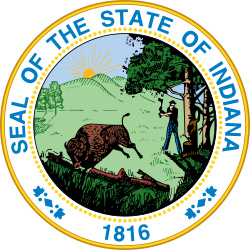Indiana House of Representatives | |
|---|---|
| Indiana General Assembly | |
 | |
| Type | |
| Type | |
Term limits | None |
| History | |
New session started | January 9, 2023 |
| Leadership | |
Speaker pro tempore | |
Majority Leader | |
Minority Leader | |
| Structure | |
| Seats | 100 |
Political groups | Majority Minority |
Length of term | 2 years |
| Authority | Article 4, Indiana Constitution |
| Salary | $33,032/year + per diem |
| Elections | |
Last election | November 5, 2024 |
Next election | November 3, 2026 |
| Redistricting | Legislative Control |
| Meeting place | |
 | |
 Indiana Statehouse Indianapolis, Indiana | |
| Website | |
| Indiana General Assembly | |
The Indiana House of Representatives is the lower house of the Indiana General Assembly, the state legislature of the U.S. state of Indiana. The House is composed of 100 members representing an equal number of constituent districts. House members serve two-year terms without term limits. According to the 2010 U.S. census, each State House district contains an average of 64,838 people.
Contents
- Terms and qualifications
- Composition of the House
- Officers
- Members of the Indiana House of Representatives
- Standing committees
- History
- 2012 Election
- Past composition of the House of Representatives
- See also
- Notes
- References
- External links
The House convenes at the Indiana Statehouse in Indianapolis.


